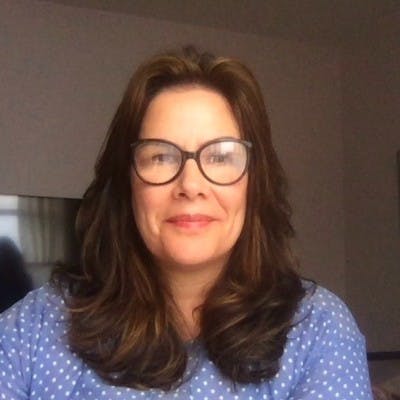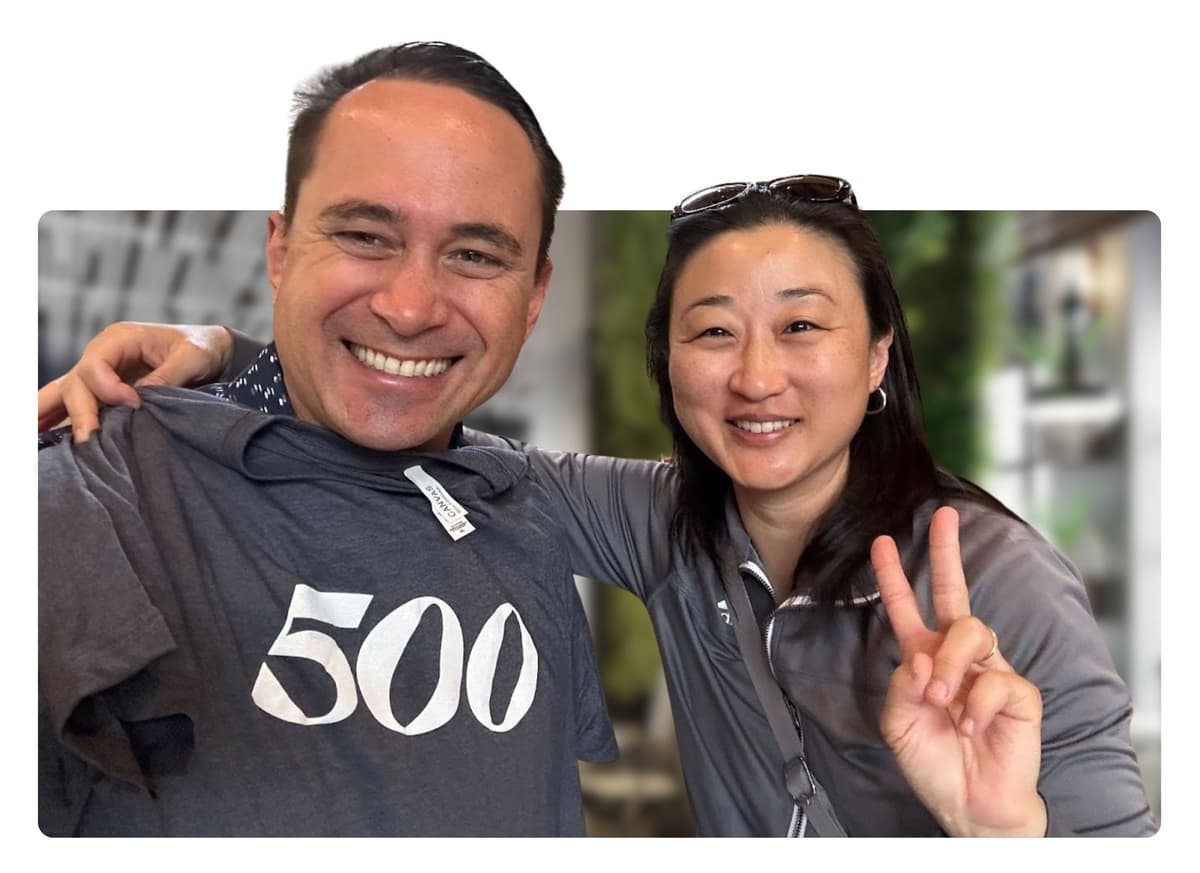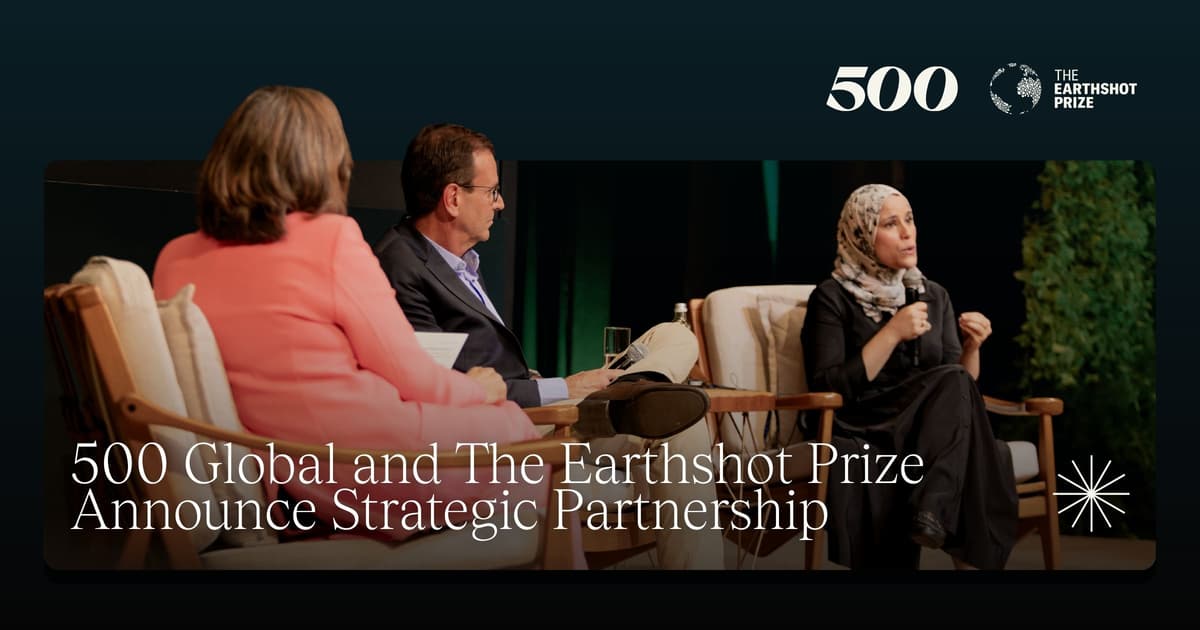Charting a path for young companies to adopt ESG practices from the start.
2022.07.14

500 Global Team

500 Global has been helping portfolio companies over the past two years implement ESG policies and practices from the start, by providing resources and guidance. Spearheading the effort is Tracy Barba, who has spent two decades in the impact investing space.
On Rise of the Next, Tracy sets the record straight on the difference between impact and ESG–something many people confuse, why the SEC’s proposed rules around “greenwashing” are a good thing, and shares some of the steps she’s taken to help 500 founders navigate ESG. The latter is uncharted territory given how young the companies are, but the ultimate goal is to minimize risk and build value. 500 Global open-sources its resources and practices, and publishes its progress in an annual report.
It is about educating early stage venture capitalists too. Last year, Tracy helped launch ESG4VC, an organization that brings together U.S.-based GPs and LPs that want to integrate ESG practices into their investment process and portfolio management.
Subscribe here to episodes of Rise of the Next on major streaming platforms.
TRANSCRIPT
Shereen Abdulla
Tracy, welcome to Rise of the Next, it’s so wonderful to have you on. I’d like to start by asking you to tell us a bit about yourself and how you got interested in ESG.
Tracy Barba
So, I’ve worked in venture capital for probably at least two decades now and I got interested in ESG because in 2007 or so I went to work for one of the funds that was an early backer of Tesla, and for the first time I saw the ability, or realized the ability, of the private capital markets, that they could advance innovation that had a positive impact on the world, and I got very excited by this idea. And so, I followed that by working in frontier markets on the impact investing side and private equity, and then went to more financing structures, that kind of social impact bonds and worked on those, and they really focus on investing money in organizations that have demonstrated their ability to have an impact either through randomized control trials or other means. All of these things kind of made me realize that private capital has the ability to really have a positive impact and caused me to start thinking about what could I do to help make that happen. So it led me to eventually join 500 and to be leading their ESG.
Shereen Abdulla
Do you mind defining ESG for our listeners, and how it’s different from impact investing, because most people confuse the two?
Tracy Barba
So this is my view of it — impact investing is about investing in companies that their end product/ service goal is to have some kind of positive social or environmental impact, and that they’re measuring that so you invest in only those types of companies. So impact investing is about filtering out — you’re not going to invest in gaming companies, you’re not going to invest in SaaS companies, unless they have some kind of positive, measurable impact. So, you design your fund investment thesis around that and screen investments based on that.
For ESG, you can invest in any type of company, whether it’s SaaS, it’s gaming, it’s fintech, and what we’re looking at is really more of the operational side of the business and looking at both risks, trying to identify risks through environmental, social, and governance issues. So, whether it’s emissions, or carbon management, or identifying it in your supply chain and figuring out how to manage for that, or if it’s about diverse and inclusive teams and building those in order to attract more talent and to build a culture, a long-term sustainable culture of attracting talent. So the E and the S and the G are really a layer that we use in our initial diligence, and what we’re looking for is just really risk and value creation opportunities.
And so, that’s different from impact in that we’re not only looking at companies, that end-product is going to have some kind of measurable, positive impact. We’re investing in all companies and with the idea that if we help them to shape their policies and practices around hiring, around carbon footprint, that is what ESG is to us at 500.
Shereen Abdulla
Now, you mentioned that any type of company can have good ESG practices. With that being said, ESG has come under the spotlight recently, and as the number of ESG funds has grown, so has the scrutiny by the SEC regarding what constitutes an ESG fund. In a down market, investors also tend to retrench to what they perceive as safer investments. So in this light, how would that shape the public’s perception of ESG?
Tracy Barba
I think a lot of the discussion around ESG has a lot to do with public market equities, right? So, lots of rating agencies have come into the mix who have helped to give a checkmark to funds that claim to be ESG. And that is coming under scrutiny, for sure — and it should. If you think about what constitutes good ESG practices, for example — so if you took the example, let’s take the startups because that’s the easiest thing right now for me to compare it to — but when we’re trying to figure out or help companies figure out what their carbon footprint is, say we have a company who’s in [pick a region] and we’re trying to help them figure out what is their carbon footprint? And how will it ultimately impact their business? And how will it ultimately impact the environment? That’s the first level. And then the second level is — what do we measure? What’s good enough, right? And then do we need a third-party to validate that? So, the company can tell us they think this is good enough. We can, as investors, look at the landscape. There’s not a lot of benchmarking out there, so we have to decide, is that good enough?
There’s been an increased demand from investors who want to put money into products that have a positive social and environmental impact. And what’s happened is that it’s not an easy thing to do, but it’s an easy thing to market. So the challenge becomes that the rating agencies can give a rating, even though we live in a world of ESG, where there’s a lack of benchmarks and the standards that most companies use, which is SASB, is really driven by whether or not it has financial impact on their company. Not whether or not it has — they haven’t figured out how to quantify, necessarily, I mean — I guess there’s more advanced ways to do this, but the reason is to say somebody gives you the stamp of approval, it seems more valid if it’s a third-party that looks at your company and says, “yes, you’re doing really well, on the ESG front,” without, having talked to you, talked to your suppliers, talked to your employees. The measures that they’re using are different across the ratings agencies and investors on the public market side, either using their advisors to recommend products or they see a product labeled ESG and think, “ah, if this product is going to have a positive net impact, whether its environmental, social, etc, why wouldn’t I choose that product versus another product that isn’t ESG-rated,” without really understanding the nuance of how those companies get screened, and added to the index, if you will.
So, companies like Tesla, for example, were kicked off the S&P ESG. Why? because Tesla has had a long history — so some people would be like, “What? Why would that happen?” Well, they’ve had a long history, many lawsuits around how they’ve treated employees discrimination, etc. And no one is, for the last 10-plus years — they’ve been in these indices that were confirmed by third parties as being ESG and it was the first time that someone said, “no, wait a minute, that’s not the case.” And it has to do with the fact that there are a lot of vested interests, or a lot of capital vested interest in this, so the challenge with ESG is that there’s not a lot of standardization, there aren’t a lot of benchmarks. At the end of the day it comes down to — do you believe, or do you think, that business has a responsibility to think about all of its stakeholders, not just the bottom line.
The fundamentals of ESG is about building long-term sustainable businesses, which it is. If you look at today’s market, if companies had in place policies and practices that enabled them to understand their supply chains and where the supply chain is using more oil, for example, or in the production of their products where they’re using more oil, and they had proactively managed that to understand that. Then, in my view, that would be better governance, better risk management. When it comes to layoffs today, if they had thought about fair wages and benefits earlier on, then the impact might be lessened in terms of where we are in the market. If they had thought about diversity and inclusion, then when they are thinking about layoffs then maybe it’s not disproportionately impacting one segment of society versus another. So I don’t really — I don’t buy into this idea that there’s somehow some difference between ESG being safe or unsafe. And I think it’s separate from the quote-on-quote scrutiny. I think the scrutiny is really around the ratings agencies and has to do with public markets, and it doesn’t have anything to do with private capital today.
Shereen Abdulla
Tracy, you provide resources to portfolio companies to help them implement ESG policies and practices from the start, which is still relatively unusual. Why do you think it’s important for founders and what’s 500 Global’s process?
Tracy Barba
So our process is really just to identify where companies are on their journey, with respect to ESG. We have an exclusion list that we follow, we’re not going to invest in companies that are using child labor or that are selling things like tobacco and other things — producing weapons, etc. But when it comes to the other pieces of ESG, whether it’s: do they have non-discrimination policies in place? Are they managing or thinking about managing their carbon footprint? These kinds of things, that’s what we’re looking for. And it’s not if you have them, we’re going to invest, or if you don’t have them, we’re gonna invest, it’s more for me to understand where you are. And then looking at your business model, and then geography, which you’re working in, to understand how we can help you. In some cases, I think it’s easier and more cost-effective to start that process of thinking about that now, versus when you’re 300 or 3000 employees. It can be much more expensive to do that.
Shereen Abdulla
And how do you educate the founders?
Tracy Barba
We have tons of resources. If you go to 500.co/esg, we have, I think, produced something like 25 or so webinars to date. But I’m constantly scanning the landscape of who’s doing what in the space, and then bringing those resources to our companies, either through training, through tools, through conversations. And what I’m seeing more of now is more companies in our portfolio reaching out and asking for those tools. So they’re asking us to help them figure out what is their carbon footprint, how do they calculate it, because in some cases, they have a value proposition. You don’t have to travel to a site. For example, in one of the cases of our companies, you’re saving your carbon footprint by not getting on that plane. And so, there’s a number of companies where they see this as a way for them to demonstrate not only to measure their impact to the environment, but also their customers care about this as well. So we bring resources, we bring training and tools. We’re at the beginning stages in venture, figuring out how this works, exactly. So those tools are being developed all the time, and there’s lots and lots of different people who are working on these kinds of efforts, and we bring those to our companies on a regular basis.
Shereen Abdulla
Now, 500 has investments all over the world, Southeast Asia, MENA, and LATAM. How does ESG translate across these different markets?
Tracy Barba
So, it’s interesting. I was at a conference recently, and there was a discussion about ESG in emerging markets, and the point that was being made was — again, on the public equity side — that a lot of companies in emerging markets don’t make the cut for some of these ESG indices where they don’t get the stamp of approval because the standards are quite high. And I think that’s a fair criticism. I think for each one of the countries that we work in, you have to look at the context. So, for example, if you’re working in Malaysia versus Mexico, they’re going to have a different standard for what is considered to be diverse, right? And you have to look at demographics, you have to look at available workforce, you have to look at things like the country-level goals around sustainable development goals, for example. They’re setting targets for what the mix should be or could be for workers. Should there be more emphasizing locals or versus expats, for example. So you have to take all of those things into consideration when you’re looking at diversity as one example. You have to look at what are the available resources when it comes to energy, because in many places oil is still predominantly being used and it’s one of the cheaper options in some places. So you have to take that into consideration.
So every place has a unique context, which is why we don’t have hard and fast rules around what is good ESG. Right now we’re just trying to help companies understand how it is that they can manage environmental footprints, how they can build diverse workforces. And because we’re so global, it takes a kind of unique understanding of each market. And the good thing is that 500 has been in these markets for a long time, so we have a lot to work with in terms of context, and understanding, and history of investing in these markets. So we can leverage a lot of that to help companies figure out what would be reasonable to expect at their stage of development.
Shereen Abdulla
Now other than the regional considerations when implementing ESG at an early stage, what have been some other big challenges you saw in the process? And do you feel like you may have to write your own playbook?
Tracy Barba
Yeah, I think that the challenge is that there are no standards, that we don’t know what constitutes good. We don’t know yet what should we be asking companies to do? There’s a lot of discussion around metrics, and I think for this stage of investments that we’re working in, especially on the early stage, it’s probably not as relevant to have a list of metrics because companies are going to change. They’re going to pivot, going to discover new lines of business. And I think it’s important at the early stages to keep in mind and understand what kind of culture do you want to build, what kind of values do you want to instill in the company. But in terms of very specific metrics, I think that’s a tough one, and unfortunately, it’s something that many investors — we’re very interested in KPIs companies are run by looking at metrics and numbers.
And ESG is still somewhat ambiguous in that respect. And so, when I went about designing the ESG criteria for our fund, and the policy, and thinking about what is material, it was very difficult for me — had to take off the hat of impact investing, and really think more around the lines of operational — what we considered best practices today.
And how do we help companies achieve that, and do it in their own time, and become like a resource and a guide and a mentor to them on their journey? Not someone who thinks about it from a compliance perspective, because I think we just don’t know yet what we don’t know. And so, I took a little bit of B-Corp, I looked at SASB because when they get to public companies, get to public markets, that’s something they’re going to have to be in compliance with. So I looked and thought, okay, what can we work backwards from if we know by the time that they grow to exit on a public market, what are they’re going to be required to do? How can we start making small changes today so that they don’t have to reinvent the wheel by the time they get there or have to spend a lot of money to be in compliance. I took a lot of different standards that are out there, because they’re not designed for venture capital, early-stage venture capital, and really designed our own criteria for how we think through ESG. And then I updated, on an ongoing basis, the conversations that I’m having to understand around things like ethical tech. The unintended consequences of technology is also a big part of the discussion. How do you think about that, from the beginning when you’re building products?
These kinds of things, I think, are — many founders, I have yet to meet a founder who doesn’t want to build a diverse culture, an inclusive culture, doesn’t value making sure they have minimized their carbon footprint, wants to build products that don’t have negative impacts on society. But the question is always how and when. And that, we don’t have enough use cases, and we’re just at the beginning to figure out what that looks like. And I think we’re still a ways away from that. So yes, we have to continue to iterate. There are a number of groups that are working on this venture ESG, which is based out of Europe.
Shereen Abdulla
Isn’t that an organization that you helped launch?
Tracy Barba
I was doing my own effort in the US and then we came together. I don’t remember exactly how it is that we came together, but we found each other and I joined forces with them. And yes, I mean, I was there from the early days. I wouldn’t say that I necessarily was part of launching venture ESG. I had started ESG4VC, which was very much focused on the US market, because there’s a real difference between European and the US market in terms of the thinking around ESG, and also the regulatory frameworks that exist in Europe versus in the US. I think we’re in the early stages of it in the US, and in Europe they’re far more advanced.
But there are — the goal there is really just to create a space for community and shared learning, and to also, hopefully, help inform standards and best practices. And the way that that came about in the US was I just — as I started to develop the policy, I wanted to make it open source so that anybody could use it and then more people would contact me and ask me what I was doing and how I was doing it. And I just, for me, the goal was to get as many people as possible to start to implement some kind of policy and start measuring something so that we can start sharing that information with each other and have more data to inform benchmarks and metrics down the road.
Shereen Abdulla
That’s super. Tracy, with that, thank you for your time.
Tracy Barba
Thank you.
Shereen Abdulla
It was wonderful to have you on.
THIS PODCAST IS INTENDED SOLELY FOR GENERAL INFORMATIONAL OR EDUCATIONAL PURPOSES ONLY. UNDER NO CIRCUMSTANCES SHOULD ANY CONTENT PROVIDED AS PART OF ANY SUCH PROGRAMS, SERVICES OR EVENTS BE CONSTRUED AS INVESTMENT, LEGAL, TAX OR ACCOUNTING ADVICE BY 500 STARTUPS MANAGEMENT COMPANY, L.L.C. OR ANY OF ITS AFFILIATES (“500 GLOBAL”). 500 GLOBAL MAKES NO REPRESENTATION AS TO THE ACCURACY OR INFORMATION IN THIS PODCAST AND WHILE REASONABLE STEPS HAVE BEEN TAKEN TO ENSURE THAT THE INFORMATION HEREIN IS ACCURATE AND UP-TO-DATE, NO LIABILITY CAN BE ACCEPTED FOR ANY ERROR OR OMISSIONS AND 500 GLOBAL ACCEPTS NO RESPONSIBILITY FOR ANY LOSS WHICH MAY ARISE FROM RELIANCE ON THE INFORMATION IN THIS PODCAST. UNDER NO CIRCUMSTANCES SHOULD ANY INFORMATION OR CONTENT IN THIS PODCAST, BE CONSIDERED AS AN OFFER TO SELL OR SOLICITATION OF INTEREST TO PURCHASE ANY SECURITIES ADVISED BY 500 GLOBAL OR ANY OF ITS AFFILIATES OR REPRESENTATIVES. FURTHER, NO CONTENT OR INFORMATION IN THIS PODCAST IS INTENDED AS AN OFFER TO PROVIDE ANY INVESTMENT ADVISORY SERVICE WITH REGARD TO SECURITIES BY 500 GLOBAL. UNDER NO CIRCUMSTANCES SHOULD ANYTHING HEREIN BE CONSTRUED AS FUND MARKETING MATERIALS BY PROSPECTIVE INVESTORS CONSIDERING AN INVESTMENT INTO ANY 500 GLOBAL INVESTMENT FUND. UNDER NO CIRCUMSTANCES SHOULD ANY STATISTICS, QUOTATIONS OR OTHER CONTENT BE INTERPRETED AS TESTIMONIALS OR ENDORSEMENT OF THE INVESTMENT PERFORMANCE OF ANY 500 GLOBAL FUND BY A PROSPECTIVE INVESTOR CONSIDERING AN INVESTMENT INTO ANY 500 GLOBAL FUND. THIS PODCAST MAY CONTAIN FORWARD-LOOKING STATEMENTS WHICH INVOLVE RISKS AND UNCERTAINTIES, AND ACTUAL RESULTS MAY DIFFER MATERIALLY FROM ANY EXPECTATIONS, PROJECTIONS OR PREDICTIONS MADE OR IMPLICATED IN SUCH FORWARD-LOOKING STATEMENTS. THE PODCAST INCLUDES CONTENT DELIVERED BY AN INDEPENDENT THIRD PARTY THAT IS NOT RELATED TO OR CONTROLLED BY 500 GLOBAL. ALL VIEWS AND OPINIONS PRESENTED IN THE PODCAST BY SUCH THIRD PARTY ARE THEIR OWN VIEWS AND OPINIONS AND DO NOT REPRESENT THOSE OF 500 GLOBAL. 500 GLOBAL MAKES NO REPRESENTATIONS AS TO OR GUARANTEES OF SPECIFIC OUTCOMES FROM ATTENDING OR RELYING ON THE CONTENTS OF THE PODCAST.






